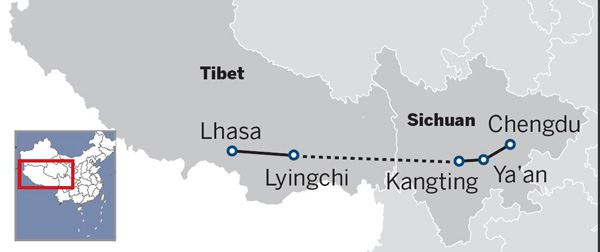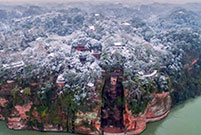


1,629-km line perched on high mountains to be complete in early 2030s
China will accelerate the construction of a 1,629-kilometer Sichuan-Tibet railway starting this year, heads of the two regions' governments confirmed.
"The government will start a preliminary survey and research of the Kangting-Lyingchi railway project this year, and accelerate the construction of Sichuan-Tibet railway in the 13th Five-Year Plan (2016-20) period," Losang Jamcan, chairman of the Tibet autonomous region government, said at the fourth session of the 10th People's Congress of Tibet in Lhasa on Wednesday.
Yin Li, acting governor of Sichuan, sent out similar message in the fourth session of the 12th People's Congress of Sichuan in Chengdu earlier.
The railway connecting Lhasa and Chengdu will be divided into three sections from west to east: Lhasa-Lyingchi, Lyingchi-Kangting, and Kangting-Chengdu.
Nearly 1,000 km of it will be in Tibet. Construction of the west and the east sections began last year. The whole project is expected to be completed in the early 2030s.
Perched at over 3,000 meters above sea level, and with more than 74 percent of its length running on bridges or in tunnels, the railway will meander through the mountains, the highest of which is over 7,000 meters.
It will cross the major rivers Minjiang, Jinshajiang and Yarlung Zangbo, said Lin Shijin, a senior civil engineer at China Railway Corp.
"The accumulated height it will climb reaches more than 14,000 meters, and it will cross many fault zones," he added. "It's like the largest rollercoaster in the world. With a designed service life of 100 years, it is believed to be one of the most difficult railway projects to build on Earth."
"It will cost at least 100 million yuan ($15.87 million) per kilometer, similar to the cost of high-speed railways on plains," said Zhao Jinxue, a rail construction risk appraiser with an insurance company in Chengdu.
The Sichuan-Tibet railway presents its builders multiple difficulties to overcome, such as avalanches, landslides, earthquakes, terrestrial heat, karst caves and underground streams, Lin said. "Yet, it is still a worthwhile project."
To travel from Chengdu to Lhasa currently takes 42 hours by train and three days by road. The rail line will shorten the travel time to less than 15 hours.
"I hope the railway can be finished as quickly as possible. Then, I'll take the train back home. It is more economical, safer and comfortable than airplanes," said Qiao Liang, a Chengdu businessman in Lhasa, who regularly commutes between the two places.
The southeast is the most populous region in Tibet, and the west of Sichuan is the least developed region of the province. The two regions are filled with breathtaking natural views and fascinating ethnic cultures.
"The railway will effectively boost tourism, and bring a new Shangri-La to the world and tangible revenue to local people," said He Ping, a tourism agency manager in Chengdu.
 Have you ever taken these beautiful subways in China?
Have you ever taken these beautiful subways in China? Chinese beauties, foreign models meet in Chengdu
Chinese beauties, foreign models meet in Chengdu Awesome! Aerial pictures taken on J-11 fighter
Awesome! Aerial pictures taken on J-11 fighter A foreign girl explains what China should be proud of
A foreign girl explains what China should be proud of Chinese navy's air-cushioned landing craft in pictures
Chinese navy's air-cushioned landing craft in pictures Chinese pole dancing master opens class in Tianjin
Chinese pole dancing master opens class in Tianjin Splendid Sichuan after snow
Splendid Sichuan after snow College girl of Vancouver crowned Miss Chinese Int'l 2016
College girl of Vancouver crowned Miss Chinese Int'l 2016 Pentagonal Mart becomes the largest vacant building in Shanghai
Pentagonal Mart becomes the largest vacant building in Shanghai Top 20 hottest women in the world in 2014
Top 20 hottest women in the world in 2014 Top 10 hardest languages to learn
Top 10 hardest languages to learn 10 Chinese female stars with most beautiful faces
10 Chinese female stars with most beautiful faces China’s Top 10 Unique Bridges, Highways and Roads
China’s Top 10 Unique Bridges, Highways and Roads Hijacking the airwaves
Hijacking the airwaves Ma’s island visit draws line for DPP
Ma’s island visit draws line for DPP Private schools attempt to keep Tibetan language alive
Private schools attempt to keep Tibetan language alive Poor reviews spark debate about Lang Lang’s musical standing
Poor reviews spark debate about Lang Lang’s musical standingDay|Week